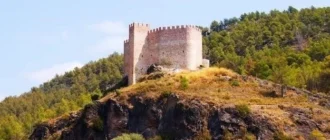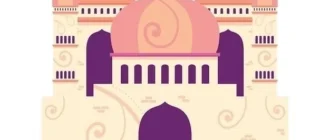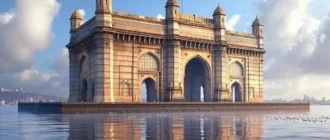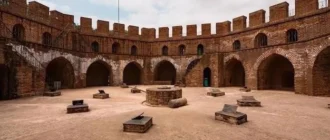Historical and Cultural Gems
Journey through Ethiopia’s captivating past in Addis Ababa, where ancient relics and architectural marvels await. Delve into the National Museum of Ethiopia, home to the iconic “Lucy” fossil and a rich collection of artifacts. Explore the grandeur of Holy Trinity Cathedral, an architectural masterpiece adorned with intricate details, and discover the cultural tapestry woven at the Ethnological Museum, nestled within the Addis Ababa University campus.
National Museum of Ethiopia
A visit to the National Museum of Ethiopia is a journey through the heart of Ethiopian history and culture. Established in 1944, this esteemed institution houses a remarkable collection of artifacts spanning millennia, offering a profound insight into the nation’s rich heritage. The museum’s diverse exhibits showcase Ethiopia’s archaeological treasures, traditional art, and cultural practices, providing a comprehensive narrative of the country’s past.
The museum’s most celebrated resident is undoubtedly “Lucy,” the 3.2-million-year-old Australopithecus afarensis skeleton, a groundbreaking discovery that revolutionized our understanding of human evolution. Lucy’s skeletal remains, meticulously preserved and displayed, offer a tangible link to our distant ancestors and highlight Ethiopia’s significant role in the story of humankind.
Beyond Lucy, the museum’s collections span a vast temporal and thematic range. Visitors can explore ancient tools and pottery from Ethiopia’s prehistoric past, delve into the grandeur of the Aksumite Empire through its intricate coins and sculptures, and marvel at the artistry of medieval Ethiopian manuscripts and religious icons. The museum also houses an extensive collection of traditional crafts and weaponry, reflecting the diverse cultures and artistic traditions of Ethiopia’s many ethnic groups.

Ethnological Museum
Nestled within the serene campus of Addis Ababa University, the Ethnological Museum offers a captivating exploration of Ethiopia’s cultural tapestry. Housed within the former palace of Emperor Haile Selassie I, the museum presents a meticulously curated collection of artifacts and exhibits that vividly portray the country’s rich cultural heritage and the diverse traditions of its many ethnic groups.
Stepping into the museum is akin to embarking on a sensory journey through the diverse landscapes and cultural expressions of Ethiopia. Exhibits are organized thematically, guiding visitors through various aspects of Ethiopian life, from daily rituals and ceremonies to art, music, and traditional attire. Each display is a window into the beliefs, values, and practices that have shaped Ethiopian identity over generations.
The museum’s collection includes a fascinating array of traditional crafts, religious artifacts, musical instruments, and household items, each imbued with cultural significance. Intricately woven textiles, adorned with symbolic patterns, highlight the artistry of Ethiopian weavers, while ceremonial masks and ritual objects offer glimpses into the spiritual beliefs of various communities. Visitors can also explore exhibits dedicated to Ethiopian coffee culture, traditional medicine, and agricultural practices, gaining a deeper understanding of the country’s enduring connection to its land and heritage.

Holy Trinity Cathedral
Standing as a beacon of faith and architectural grandeur in the heart of Addis Ababa, Holy Trinity Cathedral is a testament to Ethiopia’s rich religious heritage and artistic ingenuity. Constructed in 1942 to commemorate the country’s liberation from Italian occupation, the cathedral stands as a symbol of resilience, national pride, and spiritual devotion. Its stunning architecture, a harmonious blend of European and Ethiopian styles, draws visitors from around the world.
The cathedral’s exterior is an impressive display of intricate stonework, graceful arches, and soaring towers, crowned with copper domes that gleam under the Ethiopian sun. The main entrance, adorned with elaborate carvings depicting biblical scenes and Ethiopian motifs, leads into a cavernous interior that inspires awe and reverence.
Upon entering, visitors are greeted by a symphony of colors emanating from the cathedral’s exquisite stained glass windows. The windows, masterfully crafted to depict biblical stories and saints, bathe the interior in a kaleidoscope of light, creating an ethereal atmosphere conducive to contemplation and prayer. The cathedral’s walls are adorned with murals and paintings by renowned Ethiopian artists, showcasing the country’s artistic heritage within a sacred context.

Adadi Maryam
Nestled amidst the rugged beauty of the Entoto Mountains, approximately 40 kilometers north of Addis Ababa, lies the rock-hewn church of Adadi Maryam, a hidden gem of Ethiopian religious architecture and a testament to the country’s ancient monastic traditions. Carved directly into the face of a sheer cliff, Adadi Maryam echoes the architectural marvels of its more renowned counterpart, the rock-hewn churches of Lalibela, offering a glimpse into Ethiopia’s rich spiritual heritage and the artistry of its ancient builders.
The journey to Adadi Maryam is an adventure in itself, winding through scenic mountain roads and traditional villages, offering glimpses of rural Ethiopian life. Upon arrival, visitors are greeted by the sight of the church’s facade, intricately carved into the cliff face, its weathered stone a testament to centuries of exposure to the elements. The church’s design, with its cruciform layout and domed roof, reflects the architectural styles prevalent during the late 15th century when it was believed to have been constructed.
Stepping inside Adadi Maryam is like stepping back in time. The church’s interior, dimly lit by flickering candles and shafts of sunlight filtering through small openings, exudes an aura of serenity and ancient spirituality. The walls and ceilings are adorned with colorful murals depicting biblical scenes and saints, their vibrant pigments a testament to the skill of the artists who created them centuries ago. The air is thick with the scent of incense, and the sound of chanting monks echoes through the chambers, creating an immersive sensory experience that transports visitors to another era.
Red Terror Martyrs Memorial Museum
The Red Terror Martyrs Memorial Museum, located in Addis Ababa, stands as a poignant testament to a dark chapter in Ethiopia’s history: the Red Terror, a period of intense political repression and violence that gripped the country during the late 1970s under the Derg regime. Established in 2010, the museum serves as a somber reminder of the atrocities committed during this era and honors the memory of the countless victims who lost their lives or endured unimaginable suffering.
A visit to the museum is a deeply moving and often harrowing experience. Through a carefully curated collection of photographs, personal belongings, documents, and testimonies, the museum tells the stories of individuals whose lives were forever altered by the Red Terror. The exhibits depict the brutality of the regime, the widespread fear and paranoia that gripped society, and the resilience of the human spirit in the face of unimaginable suffering. Visitors will encounter heart-wrenching accounts of imprisonment, torture, and extrajudicial killings, brought to life through the personal stories of survivors and the families of victims.
Beyond serving as a repository of memory and a space for mourning, the Red Terror Martyrs Memorial Museum also aims to educate present and future generations about the dangers of political extremism, human rights abuses, and the importance of upholding democratic values and the rule of law. The museum’s mission extends beyond remembering the past; it strives to promote dialogue, reconciliation, and a commitment to ensuring that such atrocities are never repeated.
Immersive Experiences
Beyond its historical and cultural treasures, Addis Ababa offers a vibrant tapestry of immersive experiences that engage the senses and provide authentic glimpses into the heart of Ethiopian culture. From bustling marketplaces to lively music venues and traditional coffee ceremonies, the city invites travelers to step outside the realm of traditional sightseeing and embrace the soul of Addis Ababa.
A visit to Merkato, one of Africa’s largest open-air markets, is a feast for the senses. The air is thick with the aroma of spices, coffee, and incense, while vendors hawk their wares amidst a cacophony of sounds and colors. Navigating the labyrinthine alleys of Merkato is an adventure in itself, revealing hidden stalls overflowing with traditional crafts, textiles, jewelry, and everyday goods. It’s a place where one can haggle for souvenirs, sample local delicacies, and witness the vibrant energy of Ethiopian commerce firsthand.
For those seeking a taste of Ethiopian nightlife, a visit to Fendika Azmari Bet is a must. This legendary music venue, housed in a traditional Ethiopian building, is a hub for Ethio-jazz, a unique genre that blends traditional Ethiopian rhythms and scales with jazz improvisation. The intimate setting, adorned with local art and artifacts, creates an electrifying atmosphere where musicians and dancers captivate audiences with their energy and artistry.

Meskel Square
Meskel Square, a sprawling public plaza in the heart of Addis Ababa, pulsates with the energy and spirit of Ethiopia’s dynamic capital city. Named after the annual Meskel Festival, a vibrant religious celebration commemorating the discovery of the True Cross, the square stands as a symbol of Ethiopian identity, a gathering place for cultural events, political rallies, and the everyday rhythms of city life. A visit to Meskel Square offers a glimpse into the soul of Addis Ababa, where tradition and modernity converge against a backdrop of architectural landmarks and the ebb and flow of urban life.
Surrounded by government buildings, museums, and cultural institutions, Meskel Square serves as a focal point for Addis Ababa’s urban landscape. The square’s vast expanse, often adorned with flags, banners, and colorful decorations during festivals and celebrations, provides a sense of openness and grandeur, a space where the city’s inhabitants come together to celebrate, commemorate, or simply observe the vibrant tapestry of urban life unfolding before them.
Throughout the year, Meskel Square hosts a variety of events, from religious processions and cultural performances to political rallies and sporting events. It’s a place where one can witness the diversity and dynamism of Ethiopian society, where traditional music and dance blend with contemporary expressions of art and culture. Whether observing a lively demonstration, enjoying a cup of coffee at a street-side café, or simply soaking in the vibrant atmosphere, a visit to Meskel Square is an immersive experience that captures the essence of Addis Ababa.
Merkato Market
A visit to Merkato Market in Addis Ababa is a thrilling journey into the heart of Ethiopian commerce and culture, an assault on the senses that captures the raw energy and entrepreneurial spirit of Africa’s largest open-air market. Spread across a sprawling network of streets and alleyways, Merkato is a microcosm of Ethiopian life, where the scents of spices, coffee, and incense mingle with the vibrant colors of textiles, crafts, and produce. It’s a place where bargaining is an art form, where ancient traditions meet modern consumerism, and where the rhythms of daily life unfold amidst a cacophony of sound and movement.
Merkato is not for the faint of heart. Its crowded streets, teeming with vendors and shoppers alike, demand a sense of adventure and a willingness to embrace the unexpected. Organized into loosely defined sections by goods, from spices and coffee beans to electronics and clothing, Merkato is a treasure trove of unique finds, handcrafted goods, and everyday essentials. Whether searching for traditional Ethiopian souvenirs, sampling local delicacies, or simply immersing oneself in the vibrant tapestry of this extraordinary marketplace, Merkato offers an unforgettable sensory experience.
Beyond its commercial offerings, Merkato is a place where one can observe the social dynamics of Addis Ababa. Amidst the bustling commerce, one encounters families going about their daily shopping, groups of men sipping coffee at street-side stalls, and children weaving through the crowds, their laughter echoing through the alleyways. It’s a place where social boundaries blur, where strangers from all walks of life converge, and where the human spirit of resilience and entrepreneurship thrives.
Fendika Azmari Bet
For those seeking an authentic taste of Ethiopian musical heritage and the infectious energy of Addis Ababa’s nightlife, Fendika Azmari Bet is an unmissable destination. More than just a music venue, Fendika is a cultural institution, a vibrant hub where traditional Ethiopian music and dance converge with contemporary artistic expressions, creating an immersive experience that celebrates the soul of Ethiopian culture. Housed in a traditional Ethiopian building adorned with local art and artifacts, Fendika offers an intimate and electrifying atmosphere where the rhythms of Ethio-jazz, the soulful sounds of traditional instruments, and the mesmerizing movements of skilled dancers transport audiences to the heart of Ethiopian musical heritage.
At the heart of Fendika’s allure is Ethio-jazz, a genre that originated in Ethiopia in the 1960s, blending traditional Ethiopian scales and rhythms with the improvisational spirit of jazz. The result is a unique and captivating musical experience, characterized by complex melodies, hypnotic grooves, and the soulful interplay of instruments like the masenqo (a single-stringed bowed lute), the krar (a six-stringed lyre), and the washint (a bamboo flute).
Fendika Azmari Bet is more than just a performance space; it’s a gathering place for artists and music lovers, a place to connect with Ethiopian culture on a visceral level. The energy within Fendika is palpable, fueled by the passion of the musicians, the artistry of the dancers, and the enthusiasm of the audience. A night at Fendika is an unforgettable experience that will leave a lasting impression on anyone seeking to delve into the heart of Ethiopian music and culture.
Yod Abyssinia Cultural Restaurant
For those seeking to immerse themselves in the rich culinary and artistic traditions of Ethiopia, Yod Abyssinia Cultural Restaurant in Addis Ababa offers a captivating dining experience that tantalizes the taste buds and nourishes the soul. More than just a restaurant, Yod Abyssinia is a celebration of Ethiopian culture, a vibrant space where traditional cuisine, music, and dance intertwine to create an unforgettable sensory journey. From the moment guests step through the doors, they are enveloped in the warmth of Ethiopian hospitality and the enticing aromas of traditional spices, setting the stage for a truly immersive cultural experience.
At the heart of Yod Abyssinia’s allure is its commitment to showcasing the diversity and exquisite flavors of Ethiopian cuisine. The menu features a wide array of traditional dishes, prepared with fresh, locally sourced ingredients and infused with the aromatic spices that define Ethiopian culinary heritage. Guests can savor classic dishes like injera, a spongy flatbread served with a variety of flavorful stews, or sample kitfo, a spicy minced beef dish considered a national delicacy. Vegetarian options abound, featuring lentil stews, chickpea dishes, and a colorful array of fresh vegetables.
As guests indulge in the culinary delights of Yod Abyssinia, they are treated to a captivating performance of traditional Ethiopian music and dance. The restaurant’s stage comes alive with the rhythmic beats of traditional drums, the soulful melodies of string instruments, and the mesmerizing movements of skilled dancers adorned in vibrant costumes. The energy within Yod Abyssinia is infectious, creating a festive atmosphere where guests can’t help but clap along, tap their feet, and embrace the spirit of Ethiopian culture.
Natural Escapes
While Addis Ababa captivates with its urban dynamism and cultural riches, the city also serves as a gateway to breathtaking natural escapes that offer respite from the bustling metropolis. Within a short drive from the city center, travelers can trade the sounds of urban life for the tranquility of verdant hills, ancient forests, and panoramic vistas that showcase the beauty of Ethiopia’s highlands. These natural oases provide opportunities for hiking, wildlife viewing, and immersing oneself in the serenity of Ethiopia’s natural landscapes.
Rising above the city’s skyline, Mount Entoto, with its cool, crisp air and panoramic vistas, offers a welcome respite from the urban hustle. Once the site of Ethiopia’s ancient capital, Mount Entoto is steeped in history and legend. Visitors can explore the ruins of Emperor Menelik II’s palace, wander through the forested slopes dotted with eucalyptus trees, and visit the historic Entoto Maryam Church, renowned for its spiritual significance and traditional architecture. The summit of Mount Entoto rewards hikers with breathtaking panoramic views of Addis Ababa, showcasing the city’s sprawling urban landscape juxtaposed against the rugged beauty of the surrounding highlands.
For a different perspective on Ethiopia’s natural heritage, a visit to Unity Park, nestled within the grounds of the National Palace, offers a serene escape into a world of meticulously landscaped gardens, indigenous flora, and captivating wildlife. The park, inaugurated in 2019, celebrates Ethiopia’s cultural and biological diversity, featuring six distinct gardens representing different regions of the country. Visitors can wander through lush pathways, admire exotic plant species, and encounter indigenous animals, including the endangered Ethiopian wolf, the majestic Gelada baboon, and a variety of birdlife.
Mount Entoto
Rising majestically above the sprawling metropolis of Addis Ababa, Mount Entoto stands as a majestic natural landmark and a historical treasure, offering a captivating blend of natural beauty, cultural significance, and panoramic splendor. Reaching an elevation of over 3,200 meters, Mount Entoto provides a refreshing escape from the city’s hustle and bustle, inviting visitors to breathe in crisp mountain air, wander through ancient forests, and delve into the historical echoes of Ethiopia’s past. Whether seeking adventure, spiritual solace, or simply a moment of tranquility amidst stunning natural beauty, Mount Entoto offers a captivating retreat.
A journey to Mount Entoto is a journey back in time. Once the site of Ethiopia’s ancient capital, established by Emperor Menelik II in the late 19th century, Mount Entoto is steeped in history and legend. Visitors can explore the remnants of Menelik II’s palace, a testament to Ethiopia’s imperial past, and wander through the Entoto Maryam Church, a revered place of worship renowned for its spiritual significance and traditional Ethiopian architecture. The church, founded in 1886, houses a collection of religious relics and offers panoramic views of the surrounding landscapes.
The ascent to Mount Entoto is an adventure in itself, winding through eucalyptus forests and traditional villages, offering glimpses into the rural life that exists alongside Addis Ababa’s urban sprawl. Along the way, visitors will encounter local farmers tending to their crops, shepherds guiding their flocks, and women carrying bundles of firewood, providing a glimpse into the enduring rhythms of Ethiopian life.

Unity Park
Nestled within the historic grounds of the Grand Palace in Addis Ababa, Unity Park stands as a testament to Ethiopia’s rich cultural and natural heritage, a meticulously curated oasis that invites visitors to embark on a captivating journey through the country’s diverse landscapes, traditions, and artistic expressions. Inaugurated in 2019, Unity Park represents a vision of national unity and pride, showcasing the beauty and diversity of Ethiopia’s people, wildlife, and cultural heritage in a serene and inspiring setting. Whether seeking a moment of tranquility amidst the bustling city, an opportunity to connect with nature, or a deeper understanding of Ethiopian culture, Unity Park offers a captivating escape.
Spanning an expansive area of 40 hectares, Unity Park seamlessly blends meticulously landscaped gardens, indigenous flora, and captivating wildlife enclosures, creating a harmonious balance between nature and human artistry. The park is divided into six distinct zones, each representing a different region of Ethiopia, showcasing the country’s diverse ecosystems, architectural styles, and cultural traditions. Visitors can wander through lush gardens adorned with colorful flowers and indigenous plants, marvel at traditional homesteads representing different ethnic groups, and encounter fascinating wildlife species native to Ethiopia.
At the heart of Unity Park lies the Grand Palace, a historical landmark that has served as the seat of power for Ethiopian emperors for over a century. The palace, now partially open to the public, offers a glimpse into Ethiopia’s imperial past, showcasing opulent interiors, grand halls, and historical artifacts that reflect the country’s rich heritage. Visitors can explore the throne room, admire intricate mosaics and stained glass windows, and learn about the lives and legacies of Ethiopian rulers.
Artistic Expressions
Beyond its historical and cultural treasures, Addis Ababa pulsates with a vibrant and dynamic art scene that reflects the country’s rich artistic heritage and the creative spirit of its people. From traditional Ethiopian art forms passed down through generations to contemporary expressions that push creative boundaries, Addis Ababa’s art scene offers a captivating glimpse into the soul of Ethiopian creativity. Whether seeking traditional crafts, contemporary paintings, or thought-provoking installations, Addis Ababa’s art galleries, studios, and cultural centers provide a platform for artistic exploration and appreciation.
For those seeking an introduction to Ethiopia’s contemporary art scene, a visit to Addis Fine Art Gallery is a must. Established in 2016, Addis Fine Art has quickly become one of the city’s leading contemporary art spaces, representing a diverse roster of established and emerging Ethiopian artists working across various mediums, from painting and sculpture to photography and mixed media installations. The gallery’s carefully curated exhibitions often explore themes of identity, social commentary, and the evolving Ethiopian experience, offering thought-provoking insights into the country’s contemporary art dialogue.
Beyond the walls of formal galleries, Addis Ababa’s artistic spirit spills onto the streets, where colorful murals adorn buildings, street art adds vibrancy to public spaces, and traditional crafts are sold at bustling markets. Exploring the city’s neighborhoods reveals hidden art studios, workshops, and craft cooperatives where visitors can witness artisans at work, purchase unique souvenirs, and perhaps even try their hand at traditional Ethiopian art forms like weaving, pottery, or painting.

Addis Fine Art
For art enthusiasts and those seeking to delve into the vibrant contemporary art scene of Addis Ababa, a visit to Addis Fine Art is an absolute must. Established in 2016, Addis Fine Art has quickly emerged as a leading force in Ethiopia’s contemporary art landscape, showcasing a diverse roster of established and emerging Ethiopian artists working across a multitude of mediums, from painting and sculpture to mixed media installations and photography. The gallery’s commitment to showcasing the richness and diversity of Ethiopian contemporary art, coupled with its thoughtfully curated exhibitions that often explore pertinent social and cultural themes, makes it a captivating destination for art lovers and cultural enthusiasts alike.
Located in the heart of Addis Ababa, Addis Fine Art’s gallery space provides a welcoming and engaging environment for art appreciation. The gallery’s spacious exhibition halls are designed to showcase artwork in the best possible light, with carefully considered lighting, ample wall space, and a minimalist aesthetic that allows the artwork to take center stage. The gallery’s commitment to accessibility and engagement is evident in its efforts to provide context and information about the exhibited works, with artist statements, exhibition catalogs, and knowledgeable staff on hand to answer questions and provide insights.
Beyond its exhibitions, Addis Fine Art plays an active role in fostering and promoting Ethiopia’s contemporary art scene through artist residencies, workshops, and talks, providing a platform for artists to develop their practice, engage with audiences, and connect with the broader art world. The gallery’s commitment to nurturing artistic talent and fostering a vibrant art community has cemented its position as a leading force in Ethiopia’s burgeoning contemporary art landscape.
Modern Marvels
While Addis Ababa is renowned for its historical treasures and cultural riches, the city also stands as a testament to Ethiopia’s remarkable progress and ambition, showcasing a growing collection of modern marvels that embody the nation’s aspirations for the future. From architectural feats that redefine the city’s skyline to cutting-edge infrastructure projects and technological advancements, Addis Ababa’s modern marvels offer a glimpse into Ethiopia’s emergence as a dynamic and forward-looking nation. These achievements stand not only as symbols of progress but also as testaments to Ethiopian ingenuity and the transformative power of innovation.
One of Addis Ababa’s most striking modern marvels is the headquarters of the African Union, a testament to Ethiopia’s role as a continental leader and a symbol of pan-African unity. The towering structure, completed in 2012, dominates the city’s skyline, its sleek, modern design a departure from Addis Ababa’s traditional architecture. Beyond its architectural significance, the African Union headquarters represents Ethiopia’s commitment to fostering cooperation, development, and peace across the African continent.
In recent years, Addis Ababa has witnessed a surge in infrastructure development, with new roads, bridges, and transportation systems transforming the city’s landscape and enhancing connectivity. The Addis Ababa Light Rail Transit system, inaugurated in 2015, stands as a testament to Ethiopia’s commitment to modernizing its infrastructure and improving the lives of its citizens. The light rail system, the first of its kind in sub-Saharan Africa, provides a safe, efficient, and affordable mode of transportation for Addis Ababa’s rapidly growing population, connecting the city center to outlying neighborhoods and easing traffic congestion.

Ethiopian Airlines CFM Leap-1B Engine Test Cell
While not a conventional tourist attraction, the Ethiopian Airlines CFM Leap-1B Engine Test Cell stands as a testament to Ethiopia’s ambitions as a continental leader in aviation technology and maintenance, offering a fascinating glimpse into the cutting-edge infrastructure that supports the airline’s global operations. Located at Addis Ababa Bole International Airport, this state-of-the-art facility embodies Ethiopian Airlines’ commitment to innovation, safety, and technological advancement, solidifying its position as a leading force in African aviation.
The CFM Leap-1B Engine Test Cell represents a significant investment in Ethiopian Airlines’ maintenance, repair, and overhaul (MRO) capabilities. Equipped with the latest technology and testing equipment, the facility is specifically designed to accommodate the CFM Leap-1B engine, a highly efficient and technologically advanced engine that powers Boeing 737 MAX aircraft, a key component of Ethiopian Airlines’ fleet modernization program. The test cell allows Ethiopian Airlines to conduct comprehensive engine testing in-house, ensuring the highest standards of safety and reliability for its passengers.
The establishment of the CFM Leap-1B Engine Test Cell in Addis Ababa is a significant milestone not only for Ethiopian Airlines but also for Ethiopia’s aviation industry as a whole. The facility positions Addis Ababa as a regional hub for aircraft maintenance, attracting skilled engineers and technicians to the country and fostering the growth of a highly specialized aviation sector. Furthermore, the test cell’s presence underscores Ethiopian Airlines’ commitment to technological self-reliance, reducing its dependence on foreign MRO providers and solidifying its position as a leader in African aviation technology.










